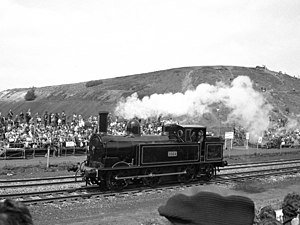0-6-2T

Front of locomotive at left
|
|||||||||||||||

Webb Coal Tank
|
|||||||||||||||
|
|||||||||||||||
|
|||||||||||||||
|
|||||||||||||||
| Equivalent classifications | |
|---|---|
| UIC class | C1 |
| French class | 031 |
| Turkish class | 34 |
| Swiss class | 3/4 |
| Russian class | 0-3-1 |
| First known tank engine version | |
|---|---|
| First use | 1880 |
| Country | United Kingdom |
| Railway | Lancashire and Yorkshire Railway |
| Designer | William Barton Wright |
| First known tender engine version | |
|---|---|
| First use | 1890 |
| Country | Cape of Good Hope |
| Locomotive | Clara Class |
| Railway | Namaqualand Railway |
| Designer | Kitson and Company |
| Builder | Kitson and Company |
Under the Whyte notation for the classification of steam locomotives, 0-6-2 represents the wheel arrangement of no leading wheels, six powered and coupled driving wheels on three axles and two trailing wheels on one axle. The type is sometimes known as a Webb or a Branchliner.
While some locomotives with this wheel arrangement had tenders, the majority were tank locomotives which carried their coal and water onboard.
Finland used two classes of 0-6-2T locomotive, the Vr2 and the Vr5.
The Vr2 class was numbered in the range from 950 to 965. Five of them are preserved in Finland, no. 950 at Joensuu, no. 951 at Tuuri, no. 953 at Haapamäki, no. 961 at Jyväskylä and no. 964 at the Veturimuseo at Toijala.
The Vr5 class was numbered in the range from 1400 to 1423. No. 1422 is preserved at Haapamäki.
Between 1890 and 1898, four 0-6-2 tender locomotives were placed in service by the Cape Copper Company on its 2 ft 6 in (762 mm) gauge Namaqualand Railway between Port Nolloth and O'okiep in the Cape Colony. Acquired to meet the traffic needs of the upper mountainous section of the line, they became known as the Mountain type. The first three of these locomotives were later described as the Clara Class, while the fourth was included in this Class by some and included in the subsequent Scotia Class by others.
Between 1900 and 1905, six more Mountain type 0-6-2 tender locomotives were placed in service by the Cape Copper Company. Later described as the Scotia Class, they were similar to the earlier Clara Class locomotives, but with longer boilers, longer fireboxes and larger firegrates.
...
Wikipedia
